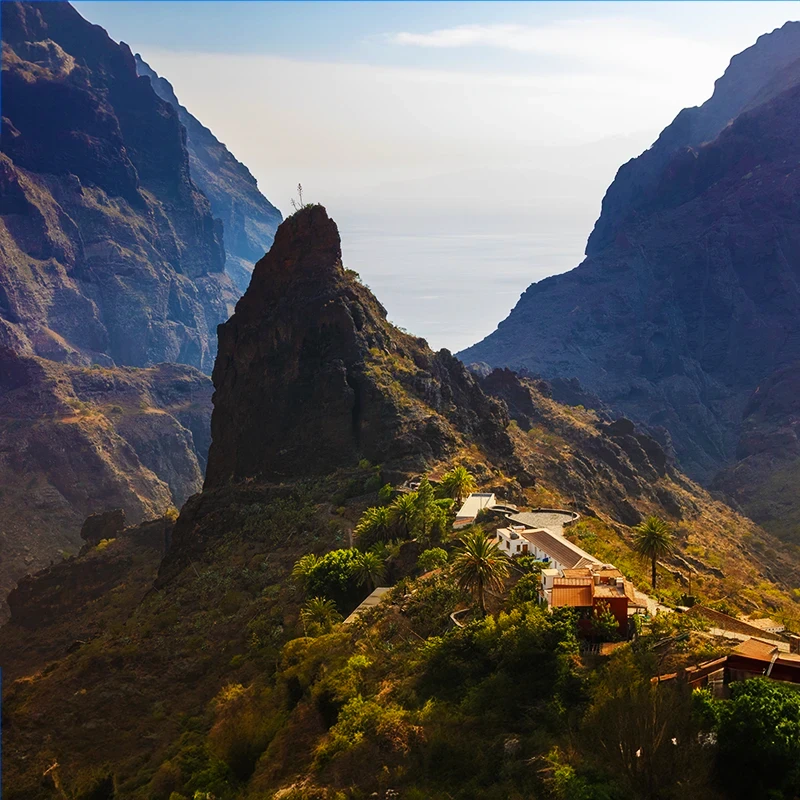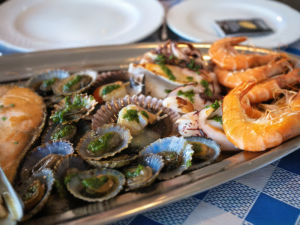
This is the food you must try when visiting Canary Islands
Tenerife, the largest of the Canary Islands, stands as a beacon of natural beauty and cultural richness. Celebrated not only for its breathtaking landscapes and vibrant culture, Tenerife is also renowned for its distinctive and flavorful cuisine. This unique culinary landscape serves as a testament to the island’s rich cultural tapestry. It incorporates a diverse blend of influences from Spanish, African, and Latin American culinary traditions, creating a gastronomy that is as varied and colorful as Tenerife itself.
At the heart of Tenerife’s gastronomy are the locally sourced ingredients that form the foundation of its dishes. The bountiful seafood from the Atlantic Ocean, the exotic fruits, and vegetables cultivated in its fertile soils—all contribute to a cuisine that is fresh, flavorful, and deeply connected to the land and sea. The island’s culinary offerings are a reflection of its geographical diversity, ranging from the coastal regions where seafood is king, to the mountainous areas where meats and hearty stews dominate the table.
Exploring Tenerife’s gastronomy leads one naturally to delve into the island’s cultural heritage, a journey well documented in literature. Books such as “Tenerife: Carne con papas y más” by Marcial Morera and “The Cuisine of the Canary Islands: Discovering Traditional Recipes and Modern Reinterpretations” by Juan Carlos Clemente capture the essence of Tenerife’s culinary tradition. Morera’s work offers an in-depth look at traditional recipes that have been passed down through generations, emphasizing the simplicity and richness of the island’s dishes.
Papas Arrugadas with Mojo
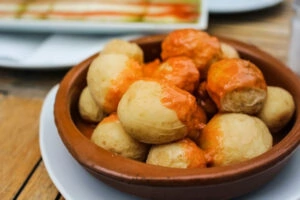
Papas arrugadas con mojo is not merely a dish; it’s an emblem of Canarian identity, embodying the simplicity and richness of the island’s culinary landscape. These small, wrinkled potatoes, boiled in sea water, emerge with a salty crust that perfectly complements the mojo sauces—mojo rojo and mojo verde. The mojo rojo, with its blend of red peppers, garlic, and spices, offers a fiery kick, while the mojo verde, made from green peppers and coriander or parsley, provides a refreshing contrast.
To truly appreciate papas arrugadas, one must delve into the traditional methods of preparation, where the choice of potato variety and the precise boiling technique play critical roles in achieving the perfect texture and flavor. The sauces, each with its unique blend of ingredients, are a testament to the Canarian people’s mastery of combining simple ingredients to create complex flavors. A meal in Tenerife is incomplete without this dish, which serves as a versatile companion to fish and meat dishes, showcasing the island’s gastronomic diversity.
Gofio: The Ancient Staple Reinvented
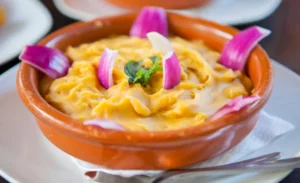
Gofio, a flour made from ground, roasted cereals, stands as a pillar of Canarian cuisine, tracing its origins back to the Guanches, the island’s indigenous inhabitants. This versatile ingredient, whether incorporated into soups, stews, desserts, or even beverages, is a remarkable example of the island’s ability to preserve its culinary heritage while adapting to contemporary tastes.
Exploring gofio’s significance in Canarian cuisine reveals its nutritional value and cultural importance. Historically, gofio was a survival food, revered for its long shelf life and high energy content. Today, it’s celebrated for its versatility and flavor, a testament to the island’s culinary ingenuity.
Chefs across Tenerife have embraced gofio, incorporating it into innovative dishes that speak to both tradition and modernity. From gofio amasado, a doughy mixture enjoyed as a snack, to sophisticated desserts that highlight its nutty flavor, gofio remains a beloved staple, connecting past and present through taste.
In addition to its culinary prowess, the tradition of using gofio in Canarian cuisine reflects the deep-seated cultural heritage of the Canary Islands. As highlighted in the renowned work by culinary historian Juan Manuel García Ramos, the roots of gofio can be traced back to the ancient Guanche civilization, where it served as a fundamental component of their diet and a symbol of sustenance.
Over the centuries, this humble flour has endured, not only as a source of nourishment but also as a symbol of resilience and identity for the Canarian people.
Seafood: A Tribute to the Atlantic’s Bounty
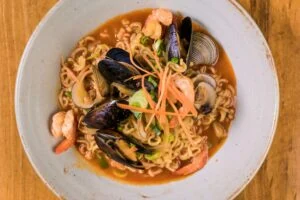
The Atlantic Ocean, with its cool, nutrient-rich waters, surrounds Tenerife, providing an abundant source of seafood that forms the backbone of the island’s culinary traditions. The local fishing communities, deeply connected to the sea, bring a variety of fish and shellfish to the table, each species telling a story of the island’s maritime heritage. The preparation of seafood in Tenerife is a testament to the philosophy of respecting the ingredient’s natural flavors.
Dishes like cherne (wreckfish) grilled to perfection, viejas (parrotfish) served in a delicate salpicón, and tender pulpo (octopus) marinated in vibrant sauces, highlight the freshness and quality of the catch.
The island’s chefs, drawing from generations of knowledge, employ techniques that enhance rather than mask the seafood’s inherent tastes. Seafood dishes in Tenerife are more than just meals; they are a celebration of the island’s geographic and cultural connection to the ocean.
Through recipes passed down through generations and innovations that embrace new culinary trends, Tenerife’s seafood cuisine continues to evolve, always rooted in the tradition of honoring the sea’s gifts.
Conejo en Salmorejo: A Culinary Heritage
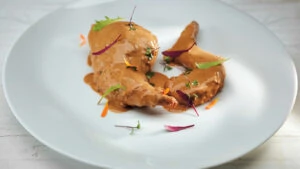
Conejo en salmorejo, rabbit in a vibrant, spicy sauce, exemplifies the depth of Tenerife’s culinary traditions. This dish, with its rich flavors and hearty texture, showcases the island’s love for game and the skillful use of local herbs and spices to create dishes that warm the soul.
The preparation of conejo en salmorejo is a labor of love, involving marination and slow cooking to ensure the rabbit meat is tender and infused with the flavors of the salmorejo sauce. The sauce, a blend of garlic, paprika, chili, and various
herbs, is a reflection of the island’s agricultural bounty and the Canarian palate’s preference for bold, spicy flavors.
Conejo en salmorejo is more than a meal; it’s a celebration of Tenerife’s rural heritage, a reminder of the days when hunting and foraging were integral to survival. Today, it stands as a proud representation of the island’s gastronomic diversity, offering a taste of the countryside’s rustic charm.
Queso Asado con Mojo: Celebrating Local Cheeses
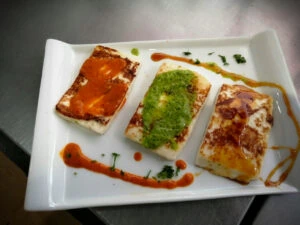
Tenerife’s cheese tradition is as rich and varied as the island’s landscapes, with queso asado con mojo highlighting the exquisite quality of local dairy production. This dish, featuring grilled cheese accompanied by mojo sauce, embodies the Canarian knack for transforming simple ingredients into culinary delights.
The selection of cheese for queso asado is crucial, with varieties ranging from the mild and creamy to the mature and robust, each offering a different taste experience. The grilling process enhances the cheese’s natural flavors, creating a slightly crispy exterior and a melt-in-your-mouth interior that pairs beautifully with the zesty mojo sauce.
Queso asado con mojo is not just a dish; it’s an ode to Tenerife’s pastoral traditions and the artisanal cheese-making practices that have been preserved across generations. It reflects the islanders’ respect for their land and the animals that graze upon it, a celebration of Tenerife’s agricultural richness.
Each section of this article delves into the heart of Tenerife’s culinary identity, exploring dishes that define the island’s gastronomy. Through these flavors, we discover the stories of Tenerife, a land where food is not just sustenance but a celebration of culture, tradition, and the natural abundance of this Atlantic jewel.
Celebrating the Festivals of Flavor: Tenerife’s Gastronomic Events
Tenerife’s rich culinary landscape is celebrated not just in its dishes but through vibrant festivals that showcase the island’s gastronomy. These events offer locals and visitors alike a taste of Tenerife’s diverse food culture, from traditional fare to contemporary culinary innovations.
One such event is the “Fiesta de San Andrés” in November, where the new wine season is welcomed with open doors in bodegas across the island, accompanied by the serving of chestnuts and traditional dishes. This festival not only celebrates the harvest but also the communal spirit of sharing food and drink.
Another highlight is the “Ruta del Almendro en Flor” in early spring, when almond trees bloom, and various towns host food markets featuring almond-based products, highlighting the importance of local ingredients in Tenerife’s cuisine.
Conclusion
In conclusion, Tenerife’s culinary journey offers an enriching exploration of flavors, traditions, and the island’s deep-rooted connection to its natural surroundings. From the fresh bounty of the sea showcased in restaurants like La Cofradía de Pescadores and Abordo to the rustic charm of conejo en salmorejo and the artisanal delight of queso asado con mojo, each dish tells a story of heritage, craftsmanship, and the islanders’ reverence for their environment. Tenerife’s unique wines, with their volcanic essence, further elevate these dining experiences, creating perfect pairings that highlight the island’s gastronomic diversity.
This exploration of Tenerife’s culinary scene is more than a testament to its delicious dishes; it is a journey through the island’s culture, showcasing how each meal is a celebration of its rich history, agricultural bounty, and the communal spirit that thrives in its kitchens and vineyards. As we savor the flavors of Tenerife, we’re not just indulging in exceptional gastronomy; we’re embracing the essence of an island that has mastered the art of combining simplicity with sophistication, tradition with innovation, and nature with culinary excellence. This is the true flavor of Tenerife – a vibrant, diverse, and deeply satisfying gastronomic adventure that invites us to appreciate the island’s culinary heritage and its ongoing commitment to culinary excellence.














